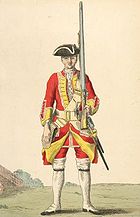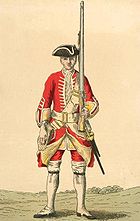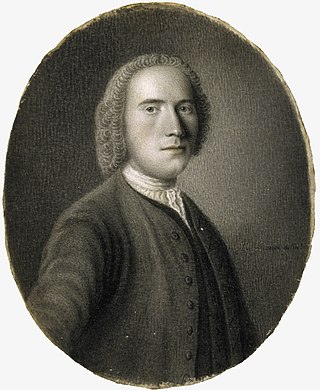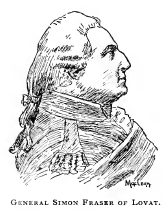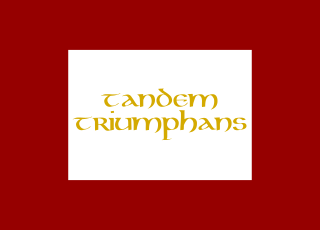Jacobite Army
Composition

The Jacobite Army is often assumed to have been largely composed of Gaelic-speaking Catholic Highlanders. In reality, nearly half of the rank and file were from the more urbanised areas of the Scottish Lowlands. [2] [3] While predominantly Scottish, it also contained some English recruits, the majority deserters from the government army. During the latter stages of the campaign, these were reinforced by detachments of Irish and Scots professionals in French service, mainly from the Royal Ecossais and Irish Brigade. Around 500 fought at Culloden, including 100 reputedly recruited from government troops captured at Fort Augustus in March. [4]
The Jacobites initially relied heavily on the traditional right of Highland chiefs to recruit their tenants for military service. However, this obligation had largely fallen into disuse, and many had to be compelled to serve with threats of eviction. As a result, desertion was an ongoing issue, while the colonels of some Highland regiments considered their men to be uncontrollable. [5] [lower-alpha 1]
A typical Highland regiment was officered by tacksmen, with their subtenants providing the rank and file. [7] [8] Tacksmen served in the front rank, and thus incurred a disproportionate number of casualties, accounting for over 25% of those incurred by the Appin regiment. [7] Although often pictured equipped with a broadsword, shield, and pistol, most of the Highland troops used muskets as their main weapon. [4]
Many Jacobite regiments, notably those recruited from Lowland areas, were organised along conventional European lines, but as with the Highland levies, these were inexperienced and poorly equipped. As the campaign progressed, supplies from France improved their equipment considerably and by April 1746 many were equipped with 0.69 in (17.5 mm) calibre French and Spanish firelocks. [4]
By the time of Culloden, most of the Jacobite cavalry had been disbanded due to a shortage of horses, with only minor elements taking part. Their heavy artillery was also largely absent, with all but one of the cannon present being light 3-pounders. [4]
Jacobite Order of Battle
Commander-in-Chief Charles Edward Stuart
Chief of staff Colonel John William Sullivan
| Division | Unit | Notes | |
|---|---|---|---|
| Prince's Escort | Fitzjames' Horse: 16 men. Lifeguards: 16 men. | ||
| Lord George Murray's Division | Atholl Brigade: 500 men | ||
| Cameron of Lochiel's Regiment: ~ 650–700 men [9] | Regarded as one of the strongest Jacobite units. | ||
| Stewarts of Appin or Appin Regiment: 250 men [10] | |||
| Lord John Drummond's Division | Lord Lovat's Regiment: ~ 300 men [11] | Though it comprised two battalions, only that commanded by Charles Fraser of Inverallochie was present; the other missed the battle by several hours. [12] | |
| Lady Mackintosh's Regiment: ~ 350 men [13] | Sometimes referred to as the Clan Chattan Regiment. A composite unit, like the Atholl Brigade, led by Alexander McGillivray of Dunmaglass, many of its officers became casualties at Culloden. | ||
| Monaltrie's Battalion of Clan Farquharson : 150 men. | Primarily raised in Braemar and Strathdee, by Francis Farquharson of Monaltrie. [14] Also included a detachment of MacGregors commanded by MacGregor of Inverenzie. [13] | ||
| Maclachlans and Macleans: ~ 200 men [13] | Commanded by Lachlan Maclachlan of Castle Lachlan, with Maclean of Drimmin as his deputy. Originally part of the Athole Brigade, Culloden was the first time it operated as a stand-alone unit. [15] | ||
| Chisholms of Strathglass: ~ 80 men [16] | Led by Roderick Og of Clan Chisholm, suffered very heavy casualties at Culloden. [15] | ||
| Duke of Perth's Division | MacDonald of Keppoch's Regiment. 200 men. | Commanded by Alexander MacDonald of Keppoch. Consisted of MacDonalds of Keppoch, MacDonalds of Glencoe, [lower-alpha 2] Mackinnons, and MacGregors. [13] | |
| MacDonald of Clanranald's Regiment: 200 men. | Commanded by MacDonald of Clanranald, younger, who was wounded during the battle. Disbanded at Fort Augustus about 18 April 1746. [15] | ||
| MacDonell of Glengarry's Regiment: 500 men. | Commanded by Donald MacDonell of Lochgarry, this regiment included 80 to 100 men from Grant of Glenmoriston and Glen Urquhart. [lower-alpha 3] | ||
| John Roy Stuart's Division (reserve) | Lord Lewis Gordon's Regiment | John Gordon of Avochie's Battalion: 300 men. | Commanded by John Gordon of Avochie. [lower-alpha 4] |
| Moir of Stonywood's Battalion: 200 men. | Recruited from Aberdeenshire by James Moir of Stonywood. | ||
| 1/Lord Ogilvy's Regiment: 200 men. | Commanded by Thomas Blair of Glassclune. | ||
| 2/Lord Ogilvy's Regiment: 300 men. | Commanded by Sir James Johnstone. | ||
| John Roy Stuart's Regiment: ~ 200 men. | Commanded by Major Patrick Stuart, who held a commission in the French Army. Raised in Edinburgh, it included deserters from the British Army, and stood in the front line at Culloden, next to the Stewarts of Appin. [18] | ||
| Footguards: ~ 200 men. | Commanded by William, Lord Kilmarnock. A composite unit formed in March 1746 by combining the dismounted Lord Kilmarnock's Horse, Lord Pisligo's Horse, and James Crichton of Auchingoul's Regiment, as well as forced recruits from Aberdeenshire, courtesy of Lady Erroll (mother-in-law to Lord Kilmarnock). [19] | ||
| Glenbucket's Regiment: 200 men. | Commanded by John Gordon of Glenbucket. | ||
| Duke of Perth's Regiment: 300 men. | Commanded by James Drummond, Master of Strathallan, this unit included two companies of MacGregors, commanded by James Mor Drummond. [13] | ||
| Irish Brigade | Royal-Ecossais : 350 men. | Commanded by Lieutenant-Colonel Lord Lewis Drummond. | |
| Irish Picquets: 302 men. | Commanded by Lieutenant-Colonel Walter Stapleton. | ||
| Cavalry (Commanded by Sir John MacDonald of Fitzjames' Horse) | Right Squadron | Fitzjames' Horse: 70 men. | Commanded by Capt William Bagot. |
| Lifeguards: 30 men. | Commanded by David, Lord Elcho. | ||
| Left Squadron | Scotch Hussars: 36 men. | Commanded by Maj John Bagot. | |
| Strathallan's Horse: 30 men. | Commanded by William, Lord Strathallan. | ||
Artillery | 11 × 3-pounders. | Commanded by Capt John Finlayson. | |
| 1 × 4-pounders. | Commanded by Capt du Saussay. | ||
